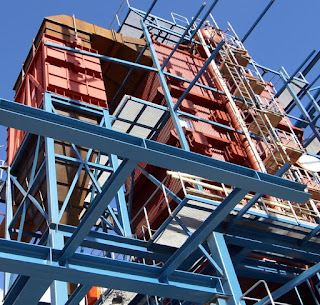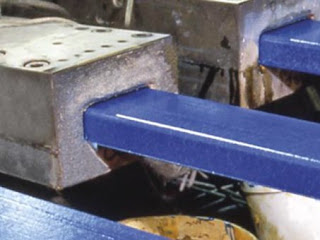A basic definition of Fiber Reinforced Polymer (FRP) is a composite material comprised of fiber (aramid, carbon, or glass – being the most common) and polymer resin commonly referred to as epoxy. FRP is a generic term for Aramid Fiber-Reinforced Polymer (AFRP), Carbon FiberReinforced Polymer (CFRP), and Glass Fiber-Reinforced Polymer (GFRP). FRP used for strengthening civil structures traces its roots to the mid-1980s with the first installations occurring in Europe and Japan. Today, thousands of rehabilitation projects around the globe have employed these composites to add strength to concrete, masonry, timber, and steel structures.
The motivation to develop FRP for civil structures was to provide an alternate to conventional strengthening methods. Some of the conventional methods include steel plates epoxy-bonded to concrete, steel plates bolted to concrete, and steel plate jacketing of round, square, and rectangular concrete columns. The obvious disadvantage of conventional methods is that they are heavy and difficult to install. In addition, once steel yields, it will stretch with little strength gain. However, FRP is linear-elastic to failure. It has roughly the same tensile modulus as steel; thereby, making it a nice alternative to steel.
Contact Process Systems & Design to discuss more about the use FRP in industrial process design and construction. Visit https://www.processsystemsdesign.com or call (410) 861-6437.
Process Systems & Design Blog
Providing information on bulk materials handling (liquid and solid), plant systems engineering, specialty machine design, and process control engineering. Industry focus for the following posts are bulk handling systems, E-Liquid (E-Juice) manufacturing equipment, Biomass, plastics and polymers. For more information, visit PS&D or call (410) 861-6437
Friday, January 19, 2018
Tuesday, January 9, 2018
Composite Materials for Industrial Construction and Process Equipment
 |
| Composite Materials for Industrial Construction. |
Typically, a composite material is made of reinforcement and a matrix. The reinforcement material provides the mechanical strength and transfers loads in the composite. The matrix binds and maintains the alignment or spacing of the reinforcement material and protects the reinforcement from abrasion or the environment. The combination of a matrix material with a strong reinforcement material enables lighter weight products relative to monolithic materials (like metals) with similar or better performance properties. Resin and fibers can be combined in a multitude of ways and further processed through a series of forming and consolidation steps. The specific manufacturing technique is dependent on the resin material, the shape and size of the component, and the structural properties required by the end use application.
The landscape of manufacturing segments and systems that benefit benefit from the lower cost, high strength and stiffness, corrosion resistant, and lightweight composite materials is growing. Successful industrial implementations for composites include material handling systems, compressed gas storage systems, heat exchangers, pipelines, geothermal energy equipment, turbine blades, structural materials for buildings, power generation flywheels, support structures for solar systems, and shipping containers, just to name a few.
For more information on applying composite materials for industrial construction or process equipment, contact Process Systems & Design at (410) 861-6437 or visit https://www.processsystemsdesign.com.
Saturday, December 30, 2017
Happy New Year from Process Systems & Design
With 2017 coming to a close, all of us at Process Systems & Design wanted to reach out and send our best wishes to our customers, our vendors, and our friends! We hope that 2018 holds success and good fortune for all of you.
Thursday, December 28, 2017
Sludge Removal by Wastewater Treatment Clarifiers
As the video below points out, dirty wastewater enters from the center of the clarifier and very slowly makes its way towards the outside where the water spills over the weir. During that retention period, the solids have enough time to settle to the bottom, where they're later picked up as sludge, and the clarified, or cleaner water, spills out along the edge. Clarifiers are made in many different shapes and sizes all work on basically the same principle. The sludge is then processed to remove water, be neutralized biologically, and reduce the levels of pathogenic organisms.
Beneficial uses of treated municipal wastewater sludges on land include agriculture and silviculture uses; application to parks, golf courses, and public lands; use in reclaiming low quality or spoiled lands; and use as landfill cover or fill material. Disposal on land includes landfilling and permanent storage of dewatered sludge or sludge incinerator ash in lagoons or piles.
Beneficial uses of treated municipal wastewater sludges on land include agriculture and silviculture uses; application to parks, golf courses, and public lands; use in reclaiming low quality or spoiled lands; and use as landfill cover or fill material. Disposal on land includes landfilling and permanent storage of dewatered sludge or sludge incinerator ash in lagoons or piles.
Tuesday, December 19, 2017
Pultruded FRP Composites as an Alternate to Steel
 |
| Pultruded FRP suspendible roof structure. |
Pultruded composite sections can be used to design and install lightweight, corrosion-resistant and electrically non-conductive alternatives to steel structures, particularly where speed and ease of construction are important. Pultruded FRP has performance characteristics similar to other construction metals, but unlike steel, it is EM/RF transparent and doesn’t disrupt equipment signals.
Benefits:
- Pound-for-pound stronger than steel.
- Comparable structural performance to other metals such as aluminum, but without the conductivity, corrosion or impact limitations.
- Can be painted, coated or pigmented during manufacture for little-to-no maintenance in highly aggressive environments
- Designed for UV performance
- Enables rapid cleaning with aggressive solvents at high pressures
- Meets industry requirements for durability, smoothness, absorbency, color, corrosion resistance and washability
- Structural profiles and plates
- Decking and planking
- Platforms, stairs, ladders and cages
- Handrails, guarding and kickplates
- Grating and gridmesh
- Bridge components
- Structural building panels
- Sheet piling and round pile
- Containment systems
- Ballistic and storm panels
- Connection hardware
Pultruded FRP composites are ideal for structural elements where a strong, lightweight material is needed; corrosion is a concern for steel or other metals; RF permeability is needed; and low thermal or electrical conductivity is important.
To discuss using pultruded FRP composites on your next project, contact Process Systems Design by calling (410) 861-6437 or visit https://www.processsystemsdesign.com.
Sunday, December 10, 2017
Consider the Possibility of Constituent By-products in Your Process Heating System
It is estimated that over 7,000 TBtu/year (Trillion British Thermal Units) of energy is used for process heating by the manufacturing sector in the United States. This energy is in the form of fuels—mostly natural gas with some coal or other fuels—and steam generated using fuels such as natural gas, coal, by-product fuels, and some others.
Combustion of these fuels results in the release of heat, which is used for process heating, and in the generation of combustion products that are discharged from the heating system. All major US industries use heating equipment such as furnaces, ovens, heaters, kilns, and dryers. The hot exhaust gases from this equipment, after providing the necessary process heat, are discharged into the atmosphere through stacks. The temperature of the exhaust gases discharged into the atmosphere from heating equipment depends on the process temperature and whether a waste heat recovery (WHR) system is used to reduce the exhaust gas temperature. The temperature of discharged gases varies from as low as 200°F to as high as 3000°F.
Combustion products themselves, generated from well-designed and well-operated burners using gaseous and light liquid fuels, are relatively clean and do not contain particles or condensable components that may require “cleanup” before discharge into the atmosphere. However, during the heating process, the combustion products may react or mix with the product being heated and may pick up constituents such as reactive gases, liquid vapors, volatiles from low-melting-temperature solid materials, particulates, condensable materials, and the like.
Some or all of these constituents, particularly at high temperatures, may react with materials used in the construction of downstream heat WHR equipment and create significant problems.
Potential Problems:
Dealing with industrial heating processes in which the exhaust gases are at high temperatures, or that contain all reactive constituents, or can be considered as harsh or contaminated are important considerations for the process engineer. If unsure, professional advice from knowledgeable consultants should be sought to optimize the heating system. To discuss any process heating requirement you may have, contact Process Systems & Design at https://www.processsystemsdesign.com or by calling (410) 861-6437.
Combustion of these fuels results in the release of heat, which is used for process heating, and in the generation of combustion products that are discharged from the heating system. All major US industries use heating equipment such as furnaces, ovens, heaters, kilns, and dryers. The hot exhaust gases from this equipment, after providing the necessary process heat, are discharged into the atmosphere through stacks. The temperature of the exhaust gases discharged into the atmosphere from heating equipment depends on the process temperature and whether a waste heat recovery (WHR) system is used to reduce the exhaust gas temperature. The temperature of discharged gases varies from as low as 200°F to as high as 3000°F.
Combustion products themselves, generated from well-designed and well-operated burners using gaseous and light liquid fuels, are relatively clean and do not contain particles or condensable components that may require “cleanup” before discharge into the atmosphere. However, during the heating process, the combustion products may react or mix with the product being heated and may pick up constituents such as reactive gases, liquid vapors, volatiles from low-melting-temperature solid materials, particulates, condensable materials, and the like.
Some or all of these constituents, particularly at high temperatures, may react with materials used in the construction of downstream heat WHR equipment and create significant problems.
Potential Problems:
- Chemical reaction of exhaust gases and their solid or vapor content with the materials used in the WHR equipment.
- Deposit of particulates in or on surfaces of WHR equipment.
- Condensation of organics such as tars and inorganic vapors such as zinc oxides and boron on heat exchanger surfaces.
- Erosion of heat exchanger components by the solids in the exhaust gases.
Dealing with industrial heating processes in which the exhaust gases are at high temperatures, or that contain all reactive constituents, or can be considered as harsh or contaminated are important considerations for the process engineer. If unsure, professional advice from knowledgeable consultants should be sought to optimize the heating system. To discuss any process heating requirement you may have, contact Process Systems & Design at https://www.processsystemsdesign.com or by calling (410) 861-6437.
Thursday, November 30, 2017
Improving Fan System Performance: A Sourcebook for Industry
 |
| Typical Fan System |
In manufacturing, fan reliability is critical to plant operation. For example, where fans serve material handling applications, fan failure will immediately create a process stoppage. In industrial ventilation applications, fan failure will often force a process to be shut down (although there is often enough time to bring the process to an orderly stoppage). Even in heating and cooling applications, fan operation is essential to maintain a productive work environment. Fan failure leads to conditions in which worker productivity and product quality declines. This is especially true for some production applications in which air cleanliness is critical to minimizing production defects (for example, plastics injection molding and electronic component manufacturing).
The document below, developed by the US DOE and the Air Movement and Control Association International provides wide ranging information about fans used in industry. You can also download your own full copy of this document from here.
Subscribe to:
Posts (Atom)


